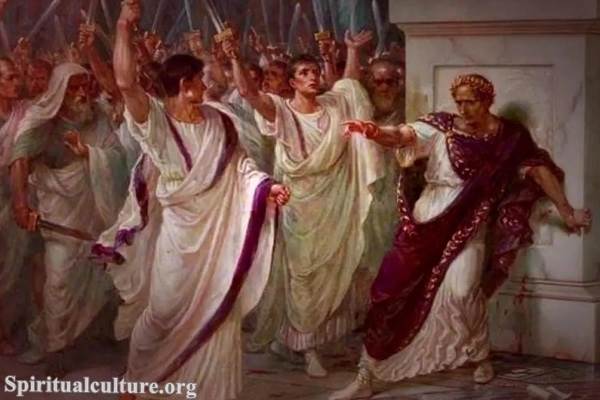Julius Caesar is a figure whose name is synonymous with leadership, ambition, and destiny. His life and death marked a pivotal turning point in Roman history, leading to the transformation of the Roman Republic into the Roman Empire.
In this article, Spiritual Culture provides an extensive detail on the timeline of Caesar’s life, chronicling his early years, political career, the rise to power, civil conflicts, and legacy. It serves not only as a historical account but also as an exploration of the deeper implications of his actions and the world in which he lived.
Early Life and Family Background
Birth and Family Heritage
Gaius Julius Caesar was born on July 12 or 13, 100 BCE, into an illustrious yet not excessively wealthy patrician family. His lineage claimed descent from Iulus, the son of Aeneas—and thus from the goddess Venus, giving his family a mythic significance that resonated throughout Roman history. The Julii family, though of noble blood, faced financial constraints that pushed young Caesar to seek a successful political career early on.
Caesar’s father, Gaius Julius Caesar, was a praetor who held significant authority while serving in the province of Asia, while his mother, Aurelia Cotta, belonged to a prominent family, ensuring that Caesar would receive a top-tier education and social connections. His noble heritage allowed him access to the upper echelons of society while instilling in him a sense of ambition and entitlement.
Early Influences and Education
Caesar’s childhood was marked by the political turbulence of the late Republic, characterized by power struggles among Rome’s elite. From a young age, he was exposed to the intricacies of Roman politics, which shaped his worldview and ambitions. His education emphasized rhetoric, philosophy, and literature—fields critical for anyone aspiring to political power in Rome.
He was tutored by Apollonius of Rhodes, an accomplished orator and philosopher who significantly influenced Caesar’s education. This instruction honed his public speaking skills and deepened his understanding of the philosophical underpinnings of leadership. By focusing on oratory, Caesar became conscious of the persuasive power of language, a realization that would play a critical role throughout his career.
Internally motivated and politically astute, young Caesar embraced the tumultuous political climate of his youth. He navigated his environment carefully, recognizing early on that Roman society was deeply divided between the patricians—the land-holding aristocracy—and the plebeians, the common people. These divisions would later fuel his political strategies.
Political Environment in Rome
The backdrop against which Caesar’s early life unfolded was one of intense political unrest. Rome was facing palpable social inequalities and political discord, particularly between two prominent factions: the Optimates, conservatives who sought to maintain the status quo and defend the interests of the aristocracy, and the Populares, who advocated for broader reforms to address the needs of the common populace.

Sulla’s dictatorship during the late 80s BCE exemplified these tensions. Sulla represented the Optimates and engaged in violent purges of his enemies, consolidating power through fear. His reign left an indelible mark on Rome, establishing a chilling precedent for political violence and authoritarian rule. This environment profoundly impacted Caesar’s political views, instilling a deepening skepticism of concentrated power that would shape his own rulership policies.
Political Career Initiation
Early Political Positions
At the age of 17, after his father’s death, Caesar began his political career. He assumed the position of military tribune, a relatively junior but essential role in the Roman military, which allowed him to gain significant firsthand experience in military and civic administration. His service brought him into contact with influential military leaders and aristocrats, expanding his political network.
In 69 BCE, he was elected quaestor, a financial officer responsible for managing the state’s treasury. His effective handling of public funds garnered him respect among his peers and marked the beginning of his ascent in the Roman political hierarchy. Caesar’s reputation as a competent administrator and his early political experience laid the groundwork for his future ambitions.
His pivotal moment came when he was appointed as the high priest, the pontifex maximus, in 63 BCE, a prestigious position that closed ranks around a small elite and bestows considerable influence. This role solidified his standing in both political and religious spheres, granting him contacts across various social strata and bolstering his public profile.
Marriage and Family Alliances
Caesar’s early political alliances relied heavily on family connections. In 84 BCE, he married Cornelia, the daughter of Lucius Cornelius Cinna, a prominent political figure aligned with the populares. This marriage strengthened his ties to Cinna’s political faction, providing him a crucial backing during his early political activities. Cornelia bore him a daughter, Julia, who later became engaged to Pompey.
However, following Sulla’s constitutional reforms and ascendency, Caesar faced personal and political challenges when he was ordered to divorce Cornelia. Sulla viewed her family as a political threat. Caesar’s refusal to comply demonstrated his commitment to his marriage and fueled his resentment toward authoritarian rule, cementing his resolve to pursue power to challenge tyrannical governance.
After Cornelia’s death, Caesar married Pompeia in 67 BCE, a granddaughter of Sulla. Their marriage aimed to heal the rifts in the traditional elite but ultimately ended in scandal when Pompeia was involved in a public affair. Fearing political backlash, Caesar divorced her, demonstrating his acute awareness of political optics and personal reputation.
Sulla’s Dictatorship and Caesar’s Response
Sulla’s period of dictatorship left an undeniable imprint on Caesar’s political ideology. Witnessing the consolidation of power through violence, Caesar developed a nuanced understanding of political maneuvering. He chose to distance himself from Sulla’s regime and its brutal legacy.
Rather than aligning himself with the Optimates, Caesar gravitated toward the Populares. He adopted policies that championed the common people’s interests, setting the stage for his advocacy for land reform and debt relief. This shift not only ingratiated him with the lower classes but also positioned him as a viable leader within Roman political discourse.
Following Sulla’s retirement and death, Caesar capitalized on the political vacuum, seizing opportunities to expand his influence and authority, marked not only by his political savvy but by the courage to oppose the entrenched powers of the elite.
Rise to Power
Formation of the First Triumvirate
In 60 BCE, Caesar entered into an unofficial alliance known as the First Triumvirate with Gnaeus Pompeius Magnus (Pompey) and Marcus Licinius Crassus, two other prominent figures in Roman politics. This alliance represented the intersection of military power and financial resources. Each member of the Triumvirate had their motives: Caesar sought military command and political clout, Pompey yearned for political support after his campaigns in the East, and Crassus dreamt of military glory to match his vast wealth.
The Triumvirate allowed Caesar to secure the governorship of the province of Gaul, where he envisioned leveraging military might to enhance his political standing. By coordinating their efforts, the three men successfully manipulated political outcomes and effectively bypassed the Senate’s authority, emphasizing a growing trend of personal power over traditional Republican governance.
Key Military Campaigns in Gaul
Caesar’s military campaigns in Gaul, which lasted from 58 to 50 BCE, became the defining episodes of his career. His campaigns were not only military exploits but also exercises in political strategy, demonstrating his capabilities as a military leader, statesman, and propagandist.
- Battle of Bibracte (58 BCE): Caesar’s confrontation with the Helvetii, a Celtic tribe migrating through Gaul, marked his first significant military engagement. The successful subjugation of the Helvetii showcased his tactical brilliance and cemented his reputation as a military commander. This victory not only established Roman dominance in the region but also bolstered his public support back in Rome.
- Battle of the Sabis (57 BCE): Engaging the Belgic tribes, this battle represented a broader campaign to consolidate Roman control in Northern Gaul. Caesar’s strategic use of terrain and formation resulted in a resounding victory, further extending Roman territory and influence.
- The campaigns against Vercingetorix (52 BCE): Vercingetorix, a chieftain of the Arverni tribe, emerged as a pivotal adversary, uniting numerous Gallic tribes against Roman encroachment. Caesar’s lengthy campaign against him culminated in the Siege of Alesia—a strategically complex operation that required tremendous logistical prowess and military acumen. The Roman victory ended significant resistance in Gaul, marking a transformative moment in Caesar’s career.
- The Return to Rome: Following his campaigns, Caesar returned to Rome not just as a military victor but also as a hero among the populace. He hosted grand celebrations and documented his exploits in his writings, Commentarii de Bello Gallico, which served both as propaganda and as historical record, showcasing his military strategies and successes.
These campaigns significantly expanded Roman territory, exemplified Caesar’s military genius, and solidified his power base. His successful conquests transformed him into a folk hero among soldiers and common citizens alike, fostering a formidable cultural legacy.
Political Reforms and Public Works
Upon returning to Rome, Caesar capitalized on his military fame by implementing a series of sweeping reforms aimed at reinforcing his political power and appeasing the populace. His reforms included:
- Land Redistribution: Understanding the plight of veterans and the impoverished, Caesar initiated land reforms to allocate land to his returning soldiers and alleviate social unrest. This initiative forged loyalty among the masses and his troops.
- Debt Relief: In a time of economic turmoil, Caesar pushed for measures to relieve debt burdens on the populace, reducing interest rates and providing debt forgiveness. This policy won him considerable admiration from the lower classes, further solidifying his support base.
- Public Works and Infrastructure: Caesar recognized the need to enhance urban infrastructure, leading to the construction of roads, public buildings, and temples. These projects not only improved the quality of life for Romans but also showcased his vision for an expanded and improved Rome, enhancing his reputation as a benevolent leader.
Through these reforms, Caesar utilized his military accomplishments to establish an enduring legacy of governance that extended well beyond military victories, reestablishing a connection with the Roman people while fostering their loyalty and respect.
Civil War and Its Consequences
Crossing the Rubicon
As tensions between Caesar and Pompey escalated, their alliance began to dissolve. Pompey, feeling threatened by Caesar’s growing power, began to align more closely with the Senate, fearing that Caesar would not relinquish control of his legions upon the end of his command in Gaul. This increasing fracture prompted factions to prepare for conflict.
The proverbial point of no return came in January 49 BCE when Caesar crossed the Rubicon River with his army, uttering the famous phrase, “Alea iacta est” (the die is cast). This act was highly symbolic, representing a declaration of war against the Senate and Pompey. The Rubicon served as a boundary; crossing it meant irrevocably entering enemy territory—an audacious act that showcased Caesar’s readiness to confront the political establishment for control.
Major Battles and Victories
Following the crossing of the Rubicon, Caesar found himself engaged in a series of critical battles, leading to swift and decisive victories against Pompey’s forces:
- Battle of Pharsalus (48 BCE): The most consequential of these battles, Pharsalus, took place against Pompey in Greece. Despite being outnumbered, Caesar’s superior tactics and decisive leadership led to a resounding victory. Pompey fled to Egypt, where he ultimately met his demise, thereby eliminating one of Caesar’s primary rivals.
- Siege of Alexandria (48-47 BCE): After Pompey’s defeat, Caesar became embroiled in the political intrigue of Egypt. He aligned himself with Cleopatra VII, an astute and ambitious ruler. The siege against various factions in Alexandria demonstrated Caesar’s ability to adapt to unfamiliar political environments and forge strategic alliances. His time in Egypt not only solidified his influence in the region but also led to a romantic liaison with Cleopatra, further intertwining their fates.
- Battle of Zela (47 BCE): Caesar’s quick and decisive victory over Pharnaces II of Pontus at the Battle of Zela, where he famously declared “Veni, Vidi, Vici” (I came, I saw, I conquered), showcased his military prowess and ability to eliminate enemies swiftly. This victory reinforced his reputation as a formidable commander and further established his authority.
By mid-47 BCE, Caesar returned to Rome, having decisively defeated his main adversaries and firmly established himself as the sole ruler of Rome.
Reforms as Dictator
Upon his return to Rome, he was appointed dictator, a title he used to implement widespread legislative changes aimed at providing stability and governance. His reforms included:
- Civil Service Reorganization: Caesar reorganized the civil service, ensuring efficient governance by appointing loyalists to key positions, thus centralizing authority and streamlining decision-making.
- Calendar Reforms: One of his notable legacies is the Julian calendar, designed to replace the Roman calendar that had fallen out of sync. By aligning it with the solar year and including leap years, Caesar emphasized his role in bringing order to Roman life.
- Extension of Citizenship: He extended Roman citizenship to many provincials in Gaul and other regions, integrating them into the political fabric of Rome. This act both solidified his power and facilitated loyalty beyond Rome’s traditional boundaries.
- Political Patronage: Caesar also maintained political patronage to secure loyalty, granting lands and positions to key supporters, a legacy that would underpin subsequent political structures in Rome.
While his governance initiatives were generally viewed favorably by the populace, they sowed seeds of discontent among many senators who perceived these actions as direct challenges to the Republican principles they held dear. The long-standing tension between autocracy and republican governance increasingly escalated as Caesar’s power consolidated.
Assassination and Aftermath
Conspiracy and Assassination Details
The increasing concentration of power in Caesar’s hands and his perceived dictatorial tendencies alarmed many within the Senate. As resentment grew, a conspiracy began to take shape among staunch republicans who feared the impending collapse of the Republic in favor of a monarchical regime. Key figures like Gaius Cassius Longinus and Marcus Junius Brutus emerged as primary conspirators intent on eliminating Caesar.
On March 15, 44 BCE, known as the Ides of March, Caesar attended a Senate meeting in the Theatre of Pompey. Despite receiving warnings about a potential attack, Caesar dismissed the concerns, showcasing both his confidence and his underestimation of the growing discontent. As he entered the Senate chamber, he was confronted by the conspirators, who surrounded him and launched their attack.
Reports suggest he was stabbed a total of 23 times, highlighting the brutality of the assassination. According to tradition, Caesar’s last words were “Et tu, Brute?” (“And you, Brutus?”), a poignant acknowledgment of betrayal by someone he considered an ally. This dramatic moment symbolized the tragic end of a man who had once possessed the power to reshape Roman governance and ideals.
Immediate Political Reactions
The assassination triggered tumultuous reactions across Rome. The conspirators initially sought public support for their cause, arguing they had freed the Republic from a tyrant. However, their belief that they had restored the Republic quickly unraveled during Caesar’s funeral, where Mark Antony delivered an impassioned speech that stirred public emotion and redirected favor toward Caesar’s memory.
Antony’s rhetoric incited riots and a surge of public fury against the conspirators. The situation devolved into chaos as mobs roamed the streets of Rome, seeking to avenge Caesar’s death. The conspirators fled, fearing for their lives, marking a rapid rise in political violence and instability.
Long-term Impact on the Roman Republic
Caesar’s assassination marked a turning point that irrevocably altered the political landscape in Rome, leading to a series of civil conflicts and the eventual downfall of the Roman Republic. While the conspirators aimed to restore Republican governance, their actions instead paved the way for further civil wars.
The ensuing power struggles saw the rise of Mark Antony, Octavian (later Augustus), and other key figures who sought to fill the power vacuum left by Caesar. The conflict between these leaders culminated in Augustus emerging victorious, establishing himself as the first Roman emperor—a title that transformed the political structure of Rome from a republic to an empire.
Caesar’s death laid bare the inherent flaws within the Republican framework—it exposed the deep-seated divisions between factions, the vulnerability of political ideals to violence, and the challenges of maintaining power. His legacy became entwined with discussions about authority, governance, and the balance between liberty and control, resonating throughout the ages.
Legacy of Julius Caesar
Influence on Roman History
Caesar’s life and death significantly influenced Roman history, marking the transition from a republic characterized by shared governance to an imperial regime ruled by a singular authority. His military conquests expanded Rome’s territory and injected newfound wealth into the empire, laying the foundations for the expansionist policies of future emperors.
His writings, especially Commentarii de Bello Gallico, serve as both historical records and military treatises, demonstrating his insights into strategy, leadership, and the art of war. These works remain essential resources in understanding not only military history but also the complexities of Roman identity and governance.
Cultural Impact and Historical Perception
The cultural impact of Julius Caesar is profound and enduring, preserved through literature, art, and drama. William Shakespeare’s Julius Caesar, a seminal work exploring themes of ambition, power, betrayal, and morality, has influenced portrayals of leadership and political ethics, emphasizing the psychological dimensions of historical figures.
Through these artistic representations, perceptions of Caesar oscillate between admiration for his brilliance and legitimate criticism for his consolidation of power. While he is sometimes viewed as a martyr for republican ideals, he is often depicted as a cautionary figure, exemplifying the tenuous nature of power and the implications of ambition.
In contemporary discussions, Caesar symbolizes the complex relationship between authority and the collective political conscience. His story serves as a touchstone for debates around liberty, governance, the role of leadership, and how the interplay of individual ambition and collective responsibility can shape the trajectory of history.
Transitional Role in Roman Governance
Caesar’s transition from general to dictator redefined the nature of leadership within Roman governance. His approach established a framework that future leaders would build upon, solidifying the transition from republican ideals to autocratic rule, wherein authority resided in the figure of the emperor.
The institutional changes he implemented, including his calendar reforms and extension of citizenship, served as blueprints for subsequent governance in both the Roman Empire and future civilizations. His actions illustrated the delicate balance between power and public sentiment—a theme that resonates profoundly in political discourse today.
Conclusion
The timeline of Julius Caesar’s life reveals a complex interplay between ambition, power, and destiny, encapsulated in one of history’s most intriguing figures. From his early struggles in a divided Rome to his military conquests and political reforms, Caesar’s journey illustrates the profound complexities of leadership and governance.
His assassination and the resulting chaos reflect the unpredictable nature of political dynamics, a theme that reverberates through time and across societies. Through the lens of history, Caesar emerges not only as a symbol of triumph and tragedy but also as a reminder of the fragile nature of political institutions and the enduring quest for power. Understanding Caesar’s timeline contributes to a deeper appreciation of the events that shaped Rome and laid the foundations for political thought in the centuries that followed, resonating with modern discussions about governance and authority. As we analyze his legacy, it becomes clear that Caesar’s life serves as a timeless study of ambition, leadership, and the intricate dance between power and the ideals of a society.




